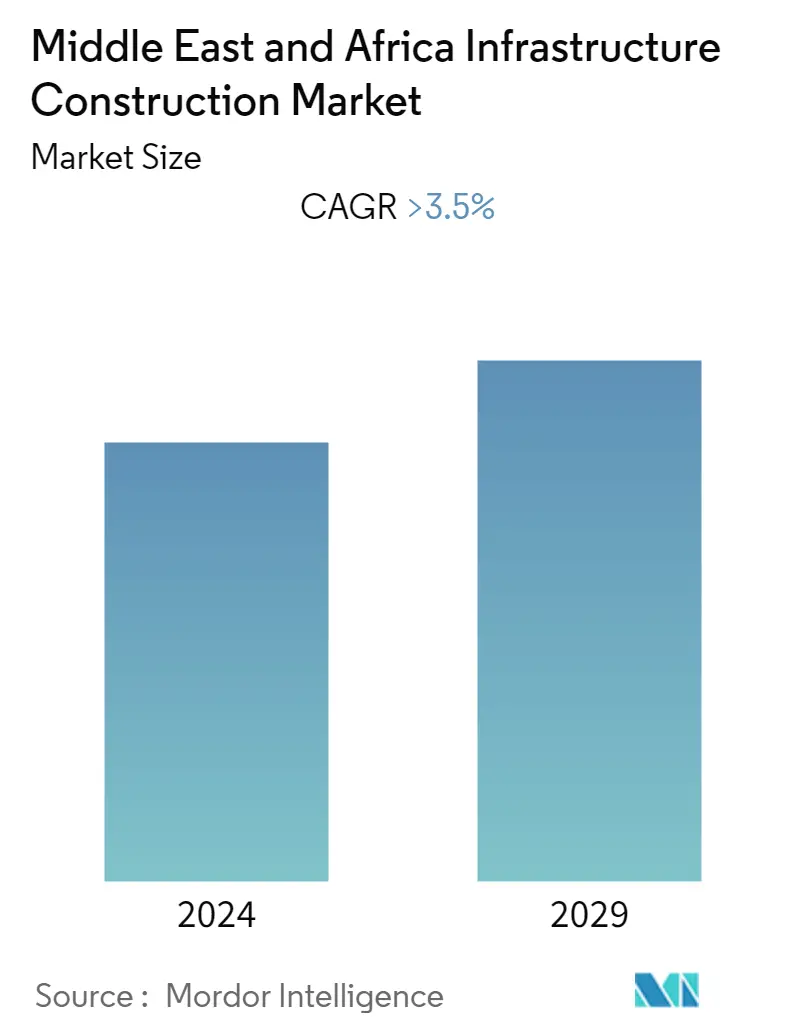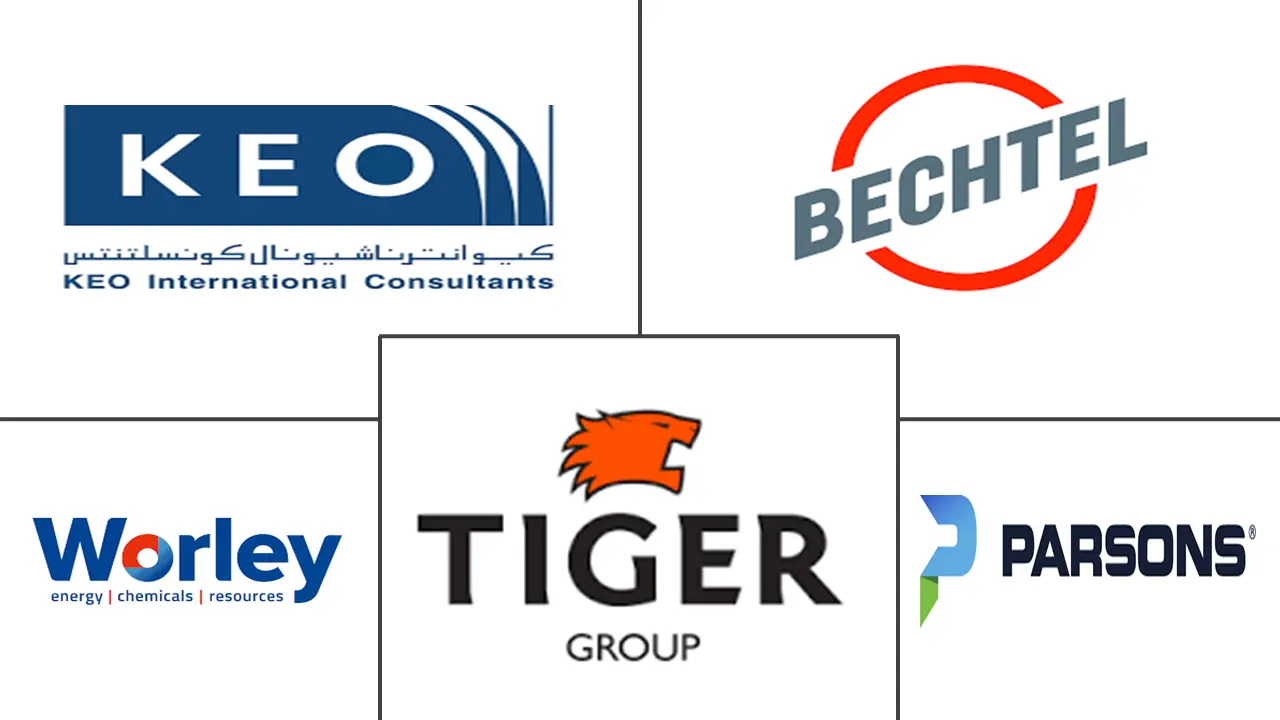Market Size of Middle East & Africa Infrastructure Construction Industry

| Study Period | 2020 - 2029 |
| Base Year For Estimation | 2023 |
| Forecast Data Period | 2024 - 2029 |
| Historical Data Period | 2020 - 2022 |
| CAGR | 3.50 % |
| Market Concentration | High |
Major Players
*Disclaimer: Major Players sorted in no particular order |
Middle East & Africa Infrastructure Construction Market Analysis
The Middle East & Africa Infrastructure Construction Market is valued at USD 48 Billion and is expected to register a CAGR of 3.5% during the forecast period. Before any specific Middle Eastern country implemented any steps, the pandemic's effects were first felt in January 2020.
- A supply chain delay resulted from China closing its borders, which was rapidly felt by numerous projects. Shipments of commodities and materials for building projects were suspended as a result.
- Additionally, because of travel restrictions in much of the Far East and the fact that many of the contractors working in the Middle East are from China and South Korea in particular, many contractors had difficulty mobilizing (or re-mobilizing) a significant portion of their management and supervision resources.
- As Covid-19 outbreaks spread throughout the Middle East, some governments acted to safeguard their inhabitants and communities, with varying degrees of impact on construction projects.
- Over the coming years, the Kingdom has various new infrastructure development projects planned. Spending on these construction projects is anticipated to support both the expansion of the sector and the continued building of significant projects like NEOM.
- Saudi Arabia started the Rua Al Madinah project in August 2022 to expand the Kingdom's tourism and pilgrimage industries. Notably, the infrastructure initiative aims to strengthen Madinah's reputation as a centre of Islamic culture. The building project is being designed and carried out by Rua Al Madinah Holding Company, which is owned by PIF and is in line with Saudi Arabia's Vision 2030. By 2030, the project will, among other things, renovate 1.5 million square metres and create 47,000 hotel rooms.
- Saudi Arabia also began work on the Jeddah Central development project in August 2022. Construction of four iconic structures, including a museum, a sports stadium, a coral farm, and an opera house, is part of the USD 20 Billion infrastructure project. Additionally, more than 3,000 hotels and tourist attractions, as well as at least 17,000 homes for residents, will be constructed.
- The Shindagha Corridor Project, overseen by the Dubai Roads and Transport Authority (RTA), entails the construction of a 13 km long road network along Al Mina, Sheikh Rashid Street, Al Khaleej, and Cairo Streets in Dubai. It is noteworthy that the infrastructure project has been divided into five distinct phases, one of which entails building a 295 m bridge. The project will cost AED 5 Billion, or USD 1.37 Billion. Notably, it is anticipated that all five phases would be finished by 2027.
- The USD 2.7 Billion Sheikh Zayed double-deck road project is one of many transport and road infrastructure projects the United Arab Emirates currently has in development. There are also more less conventional projects in addition to these construction ones, such as the USD 5.9 Billion hyperloop project connecting Dubai and Abu Dhabi.
- Nigerian refineries are in a dismal state, leaving one of Africa's biggest crude oil producers to depend on petroleum imports. However, Dangote is changing that narrative with an indigenous refinery capable of processing 650,000 barrels per day, making it the largest single-train refinery in the world. The refinery spans 2,635 hectares in Lekki Free Trade Zone, Lekki, Lagos State. It is said to cost more than USD 12 billion. The refinery is expected to be fully operational by the end of 2022.
Middle East & Africa Infrastructure Construction Industry Segmentation
Infrastructure construction and civil engineering companies build large buildings, bridges, dams, pipelines, road networks, ports, railways, and aqueducts.
The Middle East & Africa Infrastructure Construction Market is segmented by Type (Social Infrastructure (Schools, Hospitals, Defense, and Other Infrastructure), Transportation Infrastructure (Railways, Roadways, Airports, Ports, Waterways), Extraction Infrastructure (Oil and Gas, Other Extraction (Minerals, Metals, and Coal), Utilities Infrastructure (Power Generation, Electricity Transmission & Distribution, Water, Gas, Telecoms), Manufacturing Infrastructure (Metal and Ore Production, Petroleum Refining, Chemical Manufacturing, Industrial Parks and Clusters, Other Infrastructure)), Country (Saudi Arabia, United Arab Emirates, Iran, South Africa, and Rest of MEA). The report offers market size and forecasts for The Middle East & Africa Infrastructure Construction Market in Value (USD Billion) for all the above segments.
| By Type | |||||||
| |||||||
| |||||||
| |||||||
| |||||||
|
| By Country | |
| Saudi Arabia | |
| United Arab Emirates | |
| Iran | |
| South Africa | |
| Rest Of MEA |
Middle East & Africa Infrastructure Construction Market Size Summary
The Middle East & Africa Infrastructure Construction Market is poised for growth, driven by significant projects and strategic developments across the region. The market, valued at USD 48 billion, is expected to experience a steady expansion over the forecast period. The impact of the COVID-19 pandemic initially disrupted supply chains and mobilization efforts, particularly affecting projects reliant on international contractors from countries like China and South Korea. However, the region has shown resilience, with countries like Saudi Arabia and the United Arab Emirates embarking on ambitious infrastructure initiatives. These include mega-projects such as NEOM and the Jeddah Central development, which aim to enhance tourism, cultural heritage, and urban development. Additionally, the UAE is advancing transport infrastructure with projects like the Shindagha Corridor and the Sheikh Zayed double-deck road, alongside innovative ventures such as the hyperloop connecting Dubai and Abu Dhabi.
In Africa, the construction sector is undergoing a transformation with numerous high-value projects aimed at modernizing urban landscapes and improving infrastructure. Countries like Nigeria are making strides with projects such as the Dangote refinery, while Kenya's Konza technopolis represents a vision for a smart city hub. The continent's focus on infrastructure development is evident in the substantial investments in energy and transportation sectors, addressing the needs of a growing population. The competitive landscape in the Middle East & Africa infrastructure construction market is marked by the presence of major international players, fostering growth and consolidation. As the region continues to invest in large-scale projects, the market is expected to maintain its momentum, offering opportunities for further expansion and development.
Middle East & Africa Infrastructure Construction Market Size - Table of Contents
-
1. MARKET INSIGHTS
-
1.1 Industry Outlook (Current Economic and Construction Market Scenario)
-
1.1.1 GDP, Fiscal Policy, Monetary Policy, Economic Activity
-
1.1.2 Inflation
-
1.1.3 Interest Rates
-
1.1.4 Exchange Rates
-
1.1.5 Consumer Confidence
-
1.1.6 Infrastructure Spending
-
1.1.7 Development Indices Ranking
-
-
1.2 Regulatory Environment, Compliance Processes, EHS Trends and Key Policy Initiatives for the Global Infrastructure Sector
-
1.3 Technological Innovations in the Construction Sector
-
-
2. MARKET SEGMENTATION
-
2.1 By Type
-
2.1.1 Social Infrastructure
-
2.1.1.1 Schools
-
2.1.1.2 Hospitals
-
2.1.1.3 Defense
-
2.1.1.4 Other Infrastructure
-
-
2.1.2 Transportation Infrastructure
-
2.1.2.1 Railways
-
2.1.2.2 Roadways
-
2.1.2.3 Airports
-
2.1.2.4 Ports
-
2.1.2.5 Waterways
-
-
2.1.3 Extraction Infrastructure
-
2.1.3.1 Oil and Gas
-
2.1.3.2 Other Extraction (Minerals, Metals, and Coal)
-
-
2.1.4 Utilities Infrastructure
-
2.1.4.1 Power Generation
-
2.1.4.2 Electricity Transmission & Distribution
-
2.1.4.3 Water
-
2.1.4.4 Gas
-
2.1.4.5 Telecoms
-
-
2.1.5 Manufacturing Infrastructure
-
2.1.5.1 Metal and Ore Production
-
2.1.5.2 Petroleum Refining
-
2.1.5.3 Chemical Manufacturing
-
2.1.5.4 Industrial Parks and Clusters
-
2.1.5.5 Other Infrastructure
-
-
-
2.2 By Country
-
2.2.1 Saudi Arabia
-
2.2.2 United Arab Emirates
-
2.2.3 Iran
-
2.2.4 South Africa
-
2.2.5 Rest Of MEA
-
-
Middle East & Africa Infrastructure Construction Market Size FAQs
What is the current Middle East & Africa Infrastructure Construction Market size?
The Middle East & Africa Infrastructure Construction Market is projected to register a CAGR of greater than 3.5% during the forecast period (2024-2029)
Who are the key players in Middle East & Africa Infrastructure Construction Market?
KEO International Consultants, Bechtel, Parsons International, Tiger Group and WorleyParsons - UAE are the major companies operating in the Middle East & Africa Infrastructure Construction Market.

